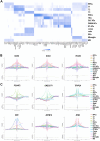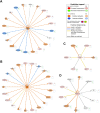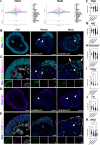Single-cell analyses reveal transient retinal progenitor cells in the ciliary margin of developing human retina
- PMID: 38670973
- PMCID: PMC11053058
- DOI: 10.1038/s41467-024-47933-x
Single-cell analyses reveal transient retinal progenitor cells in the ciliary margin of developing human retina
Abstract
The emergence of retinal progenitor cells and differentiation to various retinal cell types represent fundamental processes during retinal development. Herein, we provide a comprehensive single cell characterisation of transcriptional and chromatin accessibility changes that underline retinal progenitor cell specification and differentiation over the course of human retinal development up to midgestation. Our lineage trajectory data demonstrate the presence of early retinal progenitors, which transit to late, and further to transient neurogenic progenitors, that give rise to all the retinal neurons. Combining single cell RNA-Seq with spatial transcriptomics of early eye samples, we demonstrate the transient presence of early retinal progenitors in the ciliary margin zone with decreasing occurrence from 8 post-conception week of human development. In retinal progenitor cells, we identified a significant enrichment for transcriptional enhanced associate domain transcription factor binding motifs, which when inhibited led to loss of cycling progenitors and retinal identity in pluripotent stem cell derived organoids.
© 2024. The Author(s).
Conflict of interest statement
The authors declare no competing interests.
Figures







References
Publication types
MeSH terms
Substances
Grants and funding
LinkOut - more resources
Full Text Sources
Medical
Molecular Biology Databases

